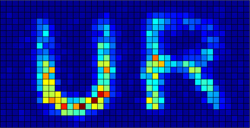
I have to say, I’m kinda floored by this one.
The above image is associated with a December 2004 press release entitled “Jefferson Lab’s journey into the nucleus” that I ran across completely by accident. The non-animated version caught my eye, in part because of the caption: “An artist’s impression of a quark being struck by a virtual photon (a). As the quark propagates through nuclear matter, it loses energy by emitting gluons (b) and creating pairs of quarks and anti-quarks (c). As the system begins to return to equilibrium, two-quark systems (pions) are formed (d).” Admirably, it starts right off with the phrase “artist’s impression.” And quite an impressionistic impression at that!
The caption that appears with the above, animated image (and, inexplicably, the title “Simple Experimental Simulation”) could use a similar qualification, in my opinion: “This movie illustrates the action inside the nucleus of a deuterium atom containing a proton and a neutron, each with three quarks. An electron strikes a quark inside a proton, passing energy to the quark before the electron bounces back. The quark now has so much energy ‘stuffed’ into it, it creates a cascade of new particles as it flies out of the proton. The result is two new, two-quark particles.”
First off, I have to note that having the GIF loop creates a problem, namely that the linear process of the reaction is shown blending back into itself. Awkward to say the least. Initially, I was inclined to blame my browser, but then I took a closer look at the file and noted that it seemed to be designed to loop, and indeed, a quick check with Adobe ImageReady revealed it to indeed be designed as a loop. Yikes! Ideally, there would at least be a few frames of black between the end and the beginning of the sequence, but to design it to loop continuously is highly misleading.
Of course, there’s plenty of misleading aspects to this representation. Basically, what we’re looking at is a Feynmann diagram, which is normally shown as a tinkertoy-type diagram of lines and squiggles (tinkertoys and springs, I guess). The imagery above includes a lot more information—colors represent different types of quarks, for example—which strikes me as rather clever and quite aesthetically pleasing, but…
What troubles me about the image is that it’s using a somewhat representational style to illustrate a fundamentally abstract concept. The almost biological quality of the pions slithering off toward the end may be rather striking, but what does it mean? In terms of communicating the underlying concepts, well, I hate to sound boring, but a more straightforward approach may be better suited. I admire Jefferson Lab for trying something different, but caution is required—or at least a cautionary note!
The initial caption, clearly indicating “artist’s impression” from the get-go, addresses my cautionary concerns, but it’d be even better if there were a brief essay by the artist involved. What choices did he or she make in creating the image? What do the colors mean? What motivated the somewhat biological look of the illustration?
In a medium better known for its objectivity than its artistry, a diagram may deserve a colorful interpretation, but as always, the subjective layer may add unintended meanings.
![]()



